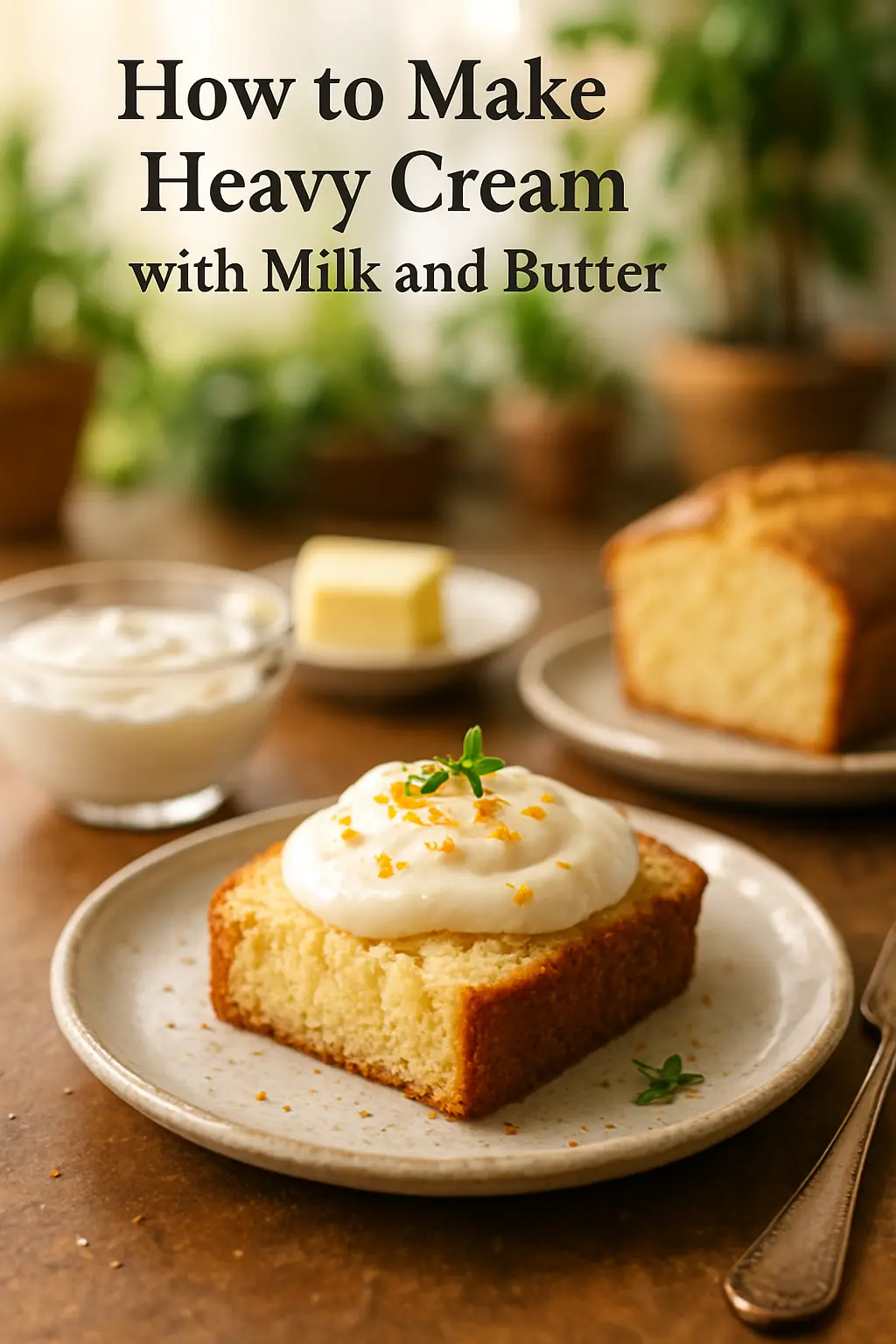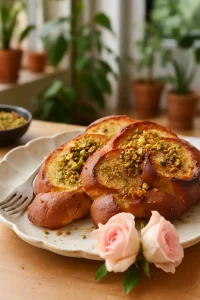How to Make Milk Cream for Ice Cream at Home

Want to learn how to make milk cream for ice cream when you’re out of heavy cream? This simple recipe transforms basic ingredients into rich, whip-able cream perfect for desserts. Whether you’re making ice cream, frosting cakes, or filling pastries, this homemade solution saves the day.
What You’ll Learn

How to Make Heavy Cream with Milk and Butter at Home
Instructions
- Melt butter and milk in a saucepan over medium-low heat, stirring constantly. Remove from heat once the butter melts completely. Avoid boiling the mixture.
- Transfer the mixture to a blender. Process on high speed (or juice setting) for one minute.
- Pour the blended mixture into a large mixing bowl. Let it cool to room temperature. Cover with plastic wrap, pressing it tightly against the surface to avoid condensation. Refrigerate overnight or until fully chilled. Store unwhipped homemade heavy cream in the fridge for up to 5 days.
- Remove the mixing bowl from the refrigerator and take off the plastic wrap. Whip the cream, adding powdered sugar or granulated sugar and vanilla extract if desired.
- Whip the cream over an ice bath if the room is warm. Gently stir the heavy whipping cream with the hand mixer beater until the powdered sugar mostly dissolves to prevent splashing during whipping.
- Whip the heavy cream using a hand mixer on medium speed until it reaches your preferred consistency. Store whipped cream in the fridge for 1 to 2 days.
Notes
Tried this recipe?
Let us know how it was!Equipment You’ll Need
Gather these basic kitchen tools before starting:
- Digital kitchen scale or measuring cups
- Blender (regular or immersion)
- Medium saucepan
- Hand mixer or stand mixer
- Large mixing bowl
- Plastic wrap
Simple Ingredients for Homemade Cream
The magic happens with just two main ingredients:
- Unsalted butter – Provides the fat content needed for whipping
- Whole milk – Creates the liquid base for proper consistency
- Optional additions – Powdered sugar or vanilla extract for flavor

Step-by-Step: How to Make Milk Cream for Ice Cream
1. Melt the Butter with Milk
Combine equal parts butter and milk in a saucepan. Heat over medium-low until the butter melts completely. Never boil cream – high heat can ruin the texture.
2. Blend Until Smooth
Transfer the warm mixture to a blender. Process on high for 1 full minute to emulsify completely. The result should look uniform with no separation.
3. Chill Overnight
Pour into a bowl, cover with plastic wrap pressed directly on the surface, and refrigerate 8+ hours. This cooling step is crucial for proper whipping later.
4. Whip to Desired Consistency
After chilling, beat with a mixer until peaks form. Add sugar or vanilla if using. For ice cream applications, medium peaks work best.

Pro Tips for Perfect Homemade Cream
- Use cold utensils – chill your bowl and beaters for better results
- Work quickly once removed from refrigeration
- For stabilized cream, add 1 tsp gelatin per cup
- If mixture separates, briefly reheat and blend again
Learn more about dairy substitutions in our comprehensive baking guide.
Best Uses for Your Homemade Cream
This versatile cream works perfectly for:
- Ice cream bases (simmer heavy cream with your flavorings)
- Whipped cream toppings
- Cake fillings and frostings
- Creamy dessert sauces
For more dessert inspiration, check out our Pinterest board with hundreds of creamy dessert ideas.
Why This Recipe Works
The 1:1 butter to milk ratio creates a fat content (about 41.5%) similar to commercial heavy cream. This allows proper whipping and stability. Lower fat mixtures won’t achieve stiff peaks needed for many desserts.

Troubleshooting Common Issues
Problem: Cream won’t whip
Solution: Ensure proper chilling time and fat ratio
Problem: Grainy texture
Solution: Blend longer initially and avoid overheating
Problem: Separation
Solution: Re-blend while slightly warm
Discover more kitchen hacks for perfect desserts every time.
Ready to Make Creamy Magic?
Now that you know how to make milk cream for ice cream and other desserts, you’ll never be caught without this essential ingredient. The process is simple, the ingredients are basic, and the results are restaurant-quality.
Pin this recipe to your dessert board and share your creations with us!
How to Make Milk Cream for Ice Cream at Home
Creating rich, velvety milk cream for ice cream is simpler than you think. The key lies in balancing fat content, sweetness, and texture. Follow this step-by-step guide to craft the perfect base for homemade ice cream.
Ingredients You’ll Need:
- 2 cups heavy cream (36-40% fat)
- 1 cup whole milk
- 3/4 cup granulated sugar
- 1/8 teaspoon fine sea salt
- 6 large egg yolks
- 2 teaspoons pure vanilla extract
Step-by-Step Process:
1. Preparing the Cream Base
Combine heavy cream and whole milk in a heavy-bottomed saucepan. The dairy mixture should contain at least 18% fat for optimal creaminess. Heat over medium-low until tiny bubbles form around the edges (about 175°F/80°C) – this is where boiling cream carefully makes all the difference.
2. Tempering the Eggs
Whisk egg yolks with sugar until pale yellow. Slowly drizzle 1/3 of the hot cream mixture into the eggs while whisking constantly. This gradual heating prevents scrambled eggs in your ice cream base.
3. Cooking the Custard
Return the tempered mixture to the saucepan. Cook over low heat, stirring constantly with a wooden spoon, until the custard thickens enough to coat the back of the spoon (about 170°F/77°C). This answers the common question “can you boil cream?” – you want it hot but never at a rolling boil.
4. Straining and Chilling
Immediately strain through a fine-mesh sieve into a clean bowl. Stir in vanilla extract. Place plastic wrap directly on the surface and refrigerate for at least 4 hours, preferably overnight.
Pro Tips for Perfect Ice Cream Cream:
- For extra richness, replace 1/4 cup milk with additional cream
- Add 1 tablespoon corn syrup to prevent ice crystals
- Infuse flavors like cinnamon or citrus zest during the initial heating
- Use an ice bath to cool the mixture quickly if short on time
The Science Behind Boiling Cream for Ice Cream
Understanding what happens when you heat cream is crucial for ice cream success. While many wonder “can you boil cream?”, the answer requires nuance.
What Happens When You Heat Cream?
As cream approaches 165°F (74°C), proteins begin to denature and fats start to emulsify. This creates the luxurious mouthfeel we associate with premium ice cream. However, true boiling (212°F/100°C) can cause:
- Protein coagulation leading to graininess
- Excessive water evaporation changing texture
- Potential separation of milk solids
Optimal Temperature Ranges
| Stage | Temperature | Purpose |
|---|---|---|
| Scalding | 175-180°F (80-82°C) | Kills bacteria, infuses flavors |
| Custard Cooking | 170-175°F (77-80°C) | Thickens without curdling |
| Danger Zone | Above 185°F (85°C) | Risk of separation |
Troubleshooting Common Cream Issues
Problem: Cream Curdled During Heating
Solution: Immediately remove from heat and blend with an immersion blender. Strain through cheesecloth to remove any graininess.
Problem: Ice Cream Too Icy
Solution: Increase cream to milk ratio (try 3:1) and add 1 tbsp vodka or 2 tbsp corn syrup per quart to lower freezing point.
Problem: Cream Won’t Whip After Heating
Solution: Ensure cream is chilled below 40°F (4°C) and contains at least 30% fat. Add 1 tbsp powdered sugar per cup to stabilize.
Advanced Techniques for Professional Results
1. Brown Butter Cream Base
Melt 1/2 cup unsalted butter until nutty brown. Strain and add to warm cream mixture. This adds incredible depth to vanilla or caramel ice creams.
2. Cream Cheese Stabilization
Blend 2 oz softened cream cheese into warm custard. The additional milk proteins prevent ice crystal formation without affecting flavor.
3. Alcohol-Infused Creams
Add 2 tbsp bourbon, rum, or liqueur after cooling. Alcohol lowers freezing point for softer scoopability.
Flavor Variations Using Your Cream Base
Chocolate Silk
Whisk 3/4 cup Dutch-process cocoa powder into hot cream mixture. Increase sugar to 1 cup.
Berry Swirl
Fold 1 cup pureed strained raspberries into chilled base before churning.
Coffee Toffee
Steep 2 tbsp espresso powder in hot cream. Mix in 1/2 cup crushed toffee bits after churning.
Equipment Recommendations
Essential Tools:
- Heavy-bottomed 3-quart saucepan
- Digital instant-read thermometer
- Fine-mesh strainer
- Silicon spatula
- Ice cream maker with compressor
Optional Upgrades:
- Immersion circulator for precise temperature control
- Chamber vacuum sealer to remove air bubbles
- Pacojet for ultra-smooth texture (commercial grade)
Storage and Serving Tips
Proper Freezing Technique
Transfer churned ice cream to an airtight container. Press parchment paper directly on the surface before freezing. Consume within 2 weeks for best texture.
Serving Temperature
Remove from freezer 10-15 minutes before serving. Ideal scooping temperature is 6-10°F (-14 to -12°C).
Reviving Frozen Ice Cream
If ice cream freezes too hard, pulse briefly in food processor or let sit at room temperature until scoopable.
Healthier Alternatives
Lower-Fat Options
Replace half the cream with evaporated milk. Add 1 tbsp arrowroot powder dissolved in 2 tbsp cold milk as a stabilizer.
Dairy-Free Version
Use full-fat coconut milk and 1/4 cup coconut oil. Add 1 tsp xanthan gum for creaminess.
Reduced-Sugar
Replace half the sugar with allulose or monk fruit sweetener. Increase egg yolks to 8 for better texture.
Frequently Asked Questions
Can you boil cream for ice cream?
While you can gently simmer cream, boiling (212°F/100°C) risks separation. Maintain temperatures between 170-180°F (77-82°C) for best results.
How long does homemade ice cream cream last?
Properly stored in an airtight container, the base lasts 3 days refrigerated or 2 months frozen. Churned ice cream maintains best quality for 2 weeks.
Why is my ice cream cream grainy?
Graininess usually indicates the eggs scrambled during cooking. Always temper eggs properly and use a thermometer to prevent overheating.
Can I use ultra-pasteurized cream?
Yes, but it may produce slightly less rich results. Ultra-pasteurization changes protein structures that affect mouthfeel.


